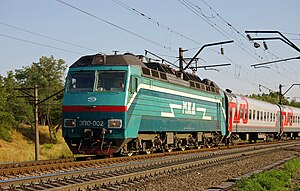RŽD series ЭП10
| RŽD series ЭП10 | |
|---|---|
|
EP10-002 in Rostov-on-Don
|
|
| Numbering: | ЭП10.001-012 |
| Number: | 12 |
| Manufacturer: |
Electric locomotive factory Novocherkassk Bombardier Transportation |
| Year of construction (s): | 1998, 2005-2006 |
| Axis formula : | Bo'Bo'Bo ' |
| Gauge : | 1520 mm |
| Top speed: | 160 km / h |
| Hourly output : | 7200 kW |
| Starting tractive effort: | 425 kN |
| Power system : | 25 kV, 50 Hz ~ 3 kV DC voltage |
| Number of traction motors: | 6th |
The locomotives of the class ЭП10 ( EP10 ) of the Rossijskije schelesnyje dorogi (RŽD) are dual-system electric locomotives for Russian broad gauge . They were developed in cooperation between Bombardier Transportation and the Novocherkassk electric locomotive factory . In 1998 a prototype locomotive appeared, from 2005–2006 the series locomotives were manufactured by the Novocherkassk electric locomotive factory. Similar to the deliveries of the ВЛ65 and ВЛ85 of the Novocherkassk electric locomotive factory, the locomotives received three two-axle bogies with the Bo'Bo'Bo 'wheel arrangement, which meant that the three-axle bogies of older designs could be avoided.
history
Due to the development of electrical engineering, the railway network in the former USSR has voltage sections of 3 kV direct current and 25 kV 50 Hz alternating current . Between the different sections there are stations with separation points for the contact line, on which the replacement between the locomotives was carried out. As this locomotive change constantly took time, two-system locomotives ( ВЛ82 and ЧС5 ) were developed as early as 1966 . In 1998 there was a further need for these multi-system locomotives in order to reduce travel times in sections with separation points. This led to the development of the ЭП10 .
development and construction
In the period from 1998 to 2006 a total of 12 locomotives of the series mentioned were built. All locomotives work in the Москва-Сортировочная-Рязанская (Moscow-Sortirobochnaja-Ryazanskaya) depot . The locomotives of this series are characterized by high performance, good dynamic starting properties and also by improved energetic properties (according to statements by train drivers, this was especially true for manual control as opposed to automatic control). The development of the electrical equipment for the locomotives comes from the Bombardier company , the mechanical equipment from the Novocherkassk electric locomotive factory .
Facilities for recuperation , systems for the automatic management of power control and the recuperation brake , a micro-recess system for diagnostics and three-phase traction motors are installed on all locomotives . It is planned to operate several locomotives in multiple controls . According to the train drivers, difficulties in small administrative matters should have arisen (lighting of the cabins, lighting of the vehicle part, inclusion / deactivation of the front lights, inclusion / deactivation of the electric heating of the train, etc.).
The size and frequency for supplying the three-phase traction motors is given by the inverter at the end of the GTO thyristors . When driving in the contact network with alternating current , the inverter receives direct current from the rectifier unit of the GTO thyristors. When the recuperation brake is activated , this system can return alternating current to the contact network.
When planning the electric traction drive motors, the customers were given very hard mass-dimension codes. As a result, the designers had little leeway to increase the performance of the engines through larger dimensions and thus more mass. Nevertheless, according to the experts, the traction drive motors were considered to be very successful in terms of their key figures.
business
All 12 delivered electric locomotives were delivered to the locomotive depot Москва-Сортировочная-Рязанская (Moscow-Sortirobochnaja-Ryazanskaya) and are still operated on the lines Moscow - Nizhny Novgorod , Moscow - Voronisch and Moscow - Kiev .
Around 2013 the majority of the electric locomotives were in operation, at the same time some of the locomotives were at the manufacturer for partial modernization . In operation, a main defect was found, that was the low reliability of the traction drive motors. A few other small flaws were also revealed. According to the newspaper, the cause was poor quality among suppliers to the Novocherkassk electric locomotive factory .
From 2011 onwards, all electric locomotives of the series ЭП10 went through the middle level of reparation in the electric locomotive repair shop in Rostov .

